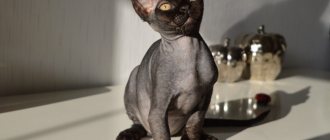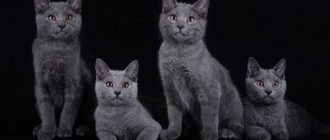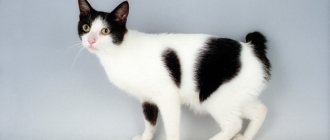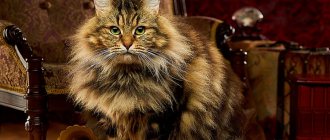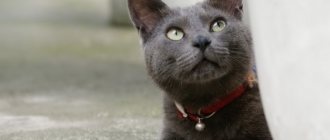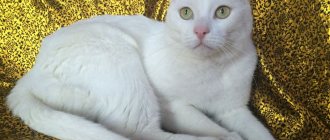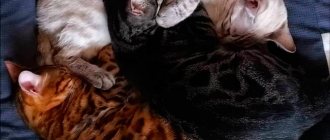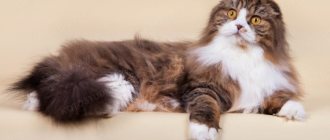Selkirk Rex
The Selkirk Rex breed appeared in 1987 in Montana (USA). In 1992, TICA was officially recognized.
Selkirk Rex
To create them, breeders used exotic, British and Persian cats.
Cats can be either short-haired or long-haired. The latter have especially pronounced curls on the collar and tail.
The coat is soft, silky, and curls chaotically. Any color is acceptable. With increased air humidity, curls become more expressive.
Habits are soft, friendly, measured.
Advantages
- playful;
- affectionate;
- unobtrusive;
- attentive.
Flaws
- arrogant;
- cunning.
Maintenance requires more careful care of the coat. When combing, the curls may straighten. Stiff metal combs must be used. It should not be given to people with allergies.
Bathing - no more than once every 2-3 months. It is important to regularly keep your eyes, ears, and mouth clean.
Laperm
Laperm appeared accidentally in 1982 in Dallas, Oregon (USA) due to a mutation in the gene responsible for wool. These cats first took part in the exhibition in 1992. Then breeding work began to strengthen the characteristics and in 2002 TICA recognized the breed.
The name of the breed comes from the English. “perm”, meaning perm.
The coat is long and curls in light, expressive waves. There are short-haired individuals - they have coarse hair. Any color is acceptable. The kitten is born hairless and begins to grow hair within the first 4 months.
Lamperm
The character is sociable, inquisitive.
Advantages
- active;
- good-natured;
- funny.
Flaws
- annoying;
- demanding.
The content does not require tricks. You need to comb it regularly 1 – 2 times a week.
Maintain hygiene of the mouth, ears, and eyes.
Types of curly cats
The first cat breed based on the rex mutation received official recognition in 1967. But despite the fact that at different times, various variants of cats with wavy and broken hair have been discovered and fixed with varying success, international felinological organizations in general perceive such experiments very skeptically.
Curly-haired cats often have difficulties with official recognition
FIFe shows maximum alertness to “curly” mutations. American associations such as TICA and CFA are somewhat more accepting of new breeds. Nevertheless, today we can talk about only five rex breeds that have received full status:
- Cornish Rex (recognized by all felinological organizations);
- Devon Rex (recognized by all felinological organizations);
- German Rex (recognized by FIFe, WCF, SCFF; not recognized by CFA);
- Selkirk (recognized by ACF, WCF, CFA, TICA, ACFA);
- Laperm (recognized by TICA, FIFe, WCF and CFA).
Cornish Rex
It was the Cornish that became the first cat breed to be awarded official recognition.
Even information has been preserved about the name of the ancestor of this type of rex mutation, as well as its owner: the cat’s name was Kalibunker, his owner was Nina Ennismore. It is known about the latter that she was engaged in breeding rabbits, and it was with her light hand that the mutation got its name.
The Cornish Rex is the first recognized breed of curly-haired cat.
The events took place in one of the English counties - Cornwall, famous for its tin mines. In 1950, an ordinary local cat gave birth to a curly-haired kitten.
Tin mining is associated with the release of radon, a natural radioactive gas that is a source of ionizing radiation that is quite dangerous to health. It is reliably known that it can cause the development of lung cancer. It is therefore likely that the cat's Cornish coat mutation is also somehow related to exposure to this gas.
Initially, as often happened with breeds based on mutations, a strange but apparently healthy baby was crossed with its own mother upon reaching puberty. But then American enthusiasts got involved, seeing photos of amazing kittens published by Nina Ennismore and buying several of them at once.
It is believed that in order to obtain viable offspring, future Cornish cats were crossed with Siamese cats, which have short hair that is almost devoid of undercoat.
The Cornish Rex is a long-legged, elegant and flexible animal with a muscular body, a wedge-shaped head with huge eyes and large ears. A characteristic feature of the breed is its thin and movable tail, similar to a whip.
A distinctive feature of the Cornish is its very thin tail.
The Cornish Rex's curly hair is so short that the cat's appearance is very similar to that of a Sphynx. However, this coat is quite dense. The waves spread out in a uniform flow from the top of the head to the tip of the tail, but their range may vary.
The breed standard allows for almost any color - from solid colors to various variations of bicolors and tabbies. The most interesting option is the so-called C-Rex - a Cornish cat with a colorpoint color.
C-rex - a cat with a Siamese color and curly hair
Photo gallery: various colors of the Cornish Rex
Solid colors of rexes can be very different
The cream Cornish Rex has an even color without a pattern.
Calico - white with faint black and red spots
Bicolor - a color in which both colors are present in significant proportions
It is worth noting that recently the European and American versions of the Cornish Rex are increasingly different from each other, moreover, experts have even begun to talk about separating the “Americans” into a separate breed. The fact is that in the USA cats of the eastern type, long-legged and graceful, are traditionally valued, while in Europe they prefer stockier animals with strong bones. That is why Americans add Oriental cat blood to their Cornish lines. As a result, not only the appearance, but also the character changes: the animal becomes more active and “talkative”.
The American line of Cornish Rex is slightly “corrected” due to the oriental cat
Video: Cornish Rex
Devon Rex
The second known Rex mutation also has English roots, and this breed was formed almost simultaneously with the Cornish.
Devon Rex is the second type of cat with curled hair, bred in England
And here's what's interesting: an almost hairless kitten with a rex mutation different from the Cornish one was discovered in Devonshire near a tin mine!
The author does not build any scientific hypotheses and does not try to manipulate the facts. Just food for thought. Tin mines were actively developed in Altenberg (Saxony) and Obergraupen (Czech Republic, Bohemia). Tin is present in copper-electrolyte sludge, the processing of which has been famous in the Sverdlovsk region since the mid-19th century. There is no direct reason to believe that the appearance of English, German, Bohemian and Ural (discovered in Yekaterinburg, former Sverdlovsk) cats with a gene mutation in fur is somehow connected with exposure to a certain radiation, but the series of coincidences slightly alarms me.
The Devonshire Rex differs from the Cornish Rex not only in the type of genetic abnormality and coat structure, but also in its overall appearance.
Let me say that if the Cornish is the embodiment of the American idea of feline beauty, then the Devons are typical Europeans!
The Devon Rex is as different from the Cornish as the European cat is from the Oriental.
These cats have a short, muscular body that makes their long legs seem a little disproportionate. The head is large, the muzzle is shortened and even slightly flattened with prominent cheekbones, like those of British cats. The chest is wide, but the neck is very thin, which also creates a feeling of some kind of imbalance. The overall picture is completed by huge, slightly slanted eyes, as if wide open in incredible amazement.
Devon Rex looks like a little gnome
Thanks to the Devon Rex, another unique cat breed was created - the Canadian Sphynx. At first, the hairless mutation could not be consolidated for a long time, since the hairless offspring died out after several generations. But the hybrid with a Devonshire cat turned out to be unexpectedly successful. The experiment was carried out without any scientific basis, but it later turned out that Canadians and Devon Rexes owe their appearance to mutations of the same gene. Its scientific designation is KRT71. Although both mutations of this gene (rex and hairless) are recessive to its normal state, baldness suppresses curly hair. Thus, the Devonshires played along perfectly with the Canadians, ensuring that they retained the initially unstable hairless gene.
Unfortunately, some very unpleasant and dangerous pathologies for the animal are associated with the Devonshire Rex mutation (more on this below). In the process of selection work, breeders try to eliminate these deviations by excluding individuals with critical deficiencies from breeding, but the problem is still far from being completely resolved.
Video: Devon Rex
German Rex
I will not tell the story of the appearance of these cats. The fact is that different sources describe completely different versions. Moreover, they are all replete with geographical names, names and dates that absolutely do not coincide with each other. Some argue that modern German rexes are direct descendants of curly-haired cats discovered in Prussia back in the 30s of the last century, others do not connect these mutations with each other.
One way or another, the German Rex received official status in 1982. The breed is not very popular in Russia, but in Europe it is considered one of the most sought after.
The German Rex was officially recognized in 1982
Describing my own impression of these animals, I will say this: in terms of the structure of their coat, they are very similar to the Cornish variety, except that the German version has a coat that is a little thicker and more elastic. But in terms of physique and overall appearance, German rexes are much closer to their Devonshire counterparts.
Selkirk Rex
Unlike the three previous breeds, the Selkirk Rex was bred in the USA, in the state of Montana. This breed is younger than its European counterparts - the mutation was first discovered in 1987, and the Selkirk received recognition already in the 1990s.
The Selkirk Rex is a very young breed of curly-haired cat that gained recognition in the 1990s.
The peculiarity of the Selkirk is that within the breed there are two varieties - long-haired and short-haired. Selkirks are fairly large animals with heavy bones. They have a powerful muscular body, a round head with a wide muzzle and a strong chin, proportionate paws and a thick, not very long tail.
Selkirks are fairly large cats with a powerful, muscular body.
The characteristic shaggyness and heaviness of the Selkirks was provided by the breeds that were used to breed this variety of curly-haired cats: British, Exotics and Persians.
The Selkirk's fur randomly sticks out in different directions, so, to be honest, I get the impression that the animal has not been combed for a long time.
Video: Selkirk Rex
Laperm
The name of this breed comes from the English word “perm” - perm.
In some sources, this breed is contrasted with the Rex, but in fact, Laperms are also a type of Rex mutation. The genetic deviation that gives cats curly hair is inherited as a dominant trait, but the Selkirk Rex is also characterized by the same feature.
Lapermas received recognition even later than Selkirks: TICA approved the breed standard in 2002, and after some time, other felinological organizations registered a new variety of curly cats.
Laperm is the last curly cat to receive official recognition
The Laperm is a long-haired variation of the curly cat. This animal has a muscular body, long legs and a slightly rounded muzzle with widely spaced ears and large slanted eyes. Laperm wool is quite hard, even a little prickly, like mohair thread. A characteristic feature of the fur coat is a sparse undercoat and a very thin awn.
I have seen how some experts at exhibitions assessed the quality of a Laperm by blowing on its fur: “correct” curls should instantly scatter to the sides at the slightest breath of wind.
Laperma's curly coat is very fine and has no undercoat.
Video: laperm
Other cat breeds with rex coat mutations
In pursuit of the unusual appearance of a pet, it is impossible to stop enthusiasts. Without thinking about the consequences of their actions and without understanding the underlying reasons for the occurrence of certain mutations, people cross animals with each other in the most unimaginable combinations. Of course, not all of the breeds listed below are the result of such experiments; some are rex mutations that have not yet been studied. And yet, in general, the trend is obvious: the demand for various kinds of mutants is growing, the rarity and unusualness of the “breed” determines the higher price for it, and, therefore, the number of strange cats that combine any possible deviations from the norm will only increase.
Table: little-known and unrecognized breeds of cats with wavy hair
| Conditional name of the breed | Country of origin | Appearance period | Brief information |
| Skookum (dwarf laperm) | USA | 1996 | An artificially bred breed, a hybrid of Laperm and Munchkin. |
| Ural rex | RF | 1988 | Cat with medium length hair. The undercoat is strongly curled, the direction of the curls is not expressed. |
| Danish Rex | Denmark | 1968 | Cats tend to become bald and their viability is questionable. |
| Oregon Rex | USA | 1944 | Presumably went extinct in 1972. |
| Czech (Bohemian) Rex | Czech | 1980s | The only successful attempt to create a curly cat based on the Persian breed. |
| Beloyarsk rex | RF | 2005 | The coat is coarser than that of the Cornish, thick and short. The curls are directed inward. |
| Maine Coon Rex (Dutch Rex) | Netherlands | 1985 | According to one version, it is a natural mutation of the American wirehair cat, according to another - a Rex mutation of the Maine Coon. |
| California Rex (Marseille cat) | USA | 1959 | Rex is a mutation similar to the Cornish, but with long hair. |
| Karakul cat | USA | 1930s | Cats with an unknown rex mutation, no offspring survived. |
| Prussian rex | East Prussia | 1930s | Brown cats with curly hair, no offspring survived. |
| Raffle | USA | 1987 | An attempt to obtain a hybrid of an American Curl and a Cornish Rex. The experiments were stopped. |
| Dakota Rex | USA | 1991 | A type of rex mutation. Work is underway to create the breed, but there is very little information about it. |
| Ohio Rex | USA | 1953 | Unknown curly coat mutation. The kittens did not survive, the experiments were stopped. |
| prairie rex | USA | — | Unsuccessful rex mutation. Breeding experiments have been discontinued. |
| Missouri Rex | USA | 1990 | A little-known variety of the shorthaired rex mutation. |
| Tennessee Rex | USA | 2004 | A type of rex mutation, work is underway to develop the breed. |
| Poodlecat | Germany | 1994 | Fold-eared curly cat. A hybrid of Carthusian, Somali, Norwegian forest cats and Maine Coons. |
| Pennsylvania (Maryland) rex | USA | 1971—1973 | An unknown rex mutation similar to the Cornish. |
Photo gallery: little-known breeds of curly-haired cats
The Tennessee Rex's coat is curly from birth.
Ural Rex is an unrecognized domestic breed
Skookum is translated from the Indian dialect as “brave”
The poodlecat is a fold-eared, curly-haired cat that is partially recognized by FIFe.
Video: Ural Rex
Skookum
Skookum was created in 1996 in Washington State (USA) by Roy Galusha by crossing a Munchkin and a Laperm. Further Europe, Australia and New Zealand took part in the breeding program. This species was recognized as experimental in 2006 by TICA. It is distinguished not only by its curliness, but also by its short limbs.
The coat is soft and can be long or short. The longer it is, the more it curls. The color can be any.
Vibrissae (sensitive hairs - mustache, eyebrows) are necessarily curly.
Skookum
Cats are brave and good-natured.
Advantages
- affectionate;
- not noisy;
- playful;
- confident;
- funny.
Flaws
- stubborn;
- demanding.
Content. It is necessary to comb regularly (1 - 2 times a week) and bathe (1 time every 1.5 - 2 months). Use cosmetics intended for animals. Keep eyes, ears, teeth clean. Representatives of the breed are not afraid of water. Bathing becomes enjoyable for both the cat and the owner.
Devon Rex
This breed appeared in the 1960s in England. Scientists decided to study the curly-haired cats accidentally spotted in Devonshire more carefully. Work has begun to strengthen the features. Over time, the Devon Rex was officially registered.
The coat is short and lies in pronounced waves over the body. Pleasant to the touch, soft. Any color is acceptable.
The character is light and lively.
Advantages
- smart;
- affectionate;
- faithful;
- inquisitive;
- unpretentious.
Flaws
- do not get along well with other animals;
- annoying;
- prone to overeating.
Care consists of frequent bathing - from weekly to monthly (the schedule is selected individually for each cat).
You also need to pay special attention to cleaning your ears.
Devon Rex
Cats are not suitable for inactive people. The Devon Rex's coat is quite sparse and almost does not cause allergies.
Main breeds
The mutation of the gene responsible for curly hair has been fixed in several varieties of cats. First of all, study the description of the most popular breeds from this category. Only after this will you finally decide for yourself whether you want to bring such a pet into your home.
Laperm
The coat of this cat is a whole variety of spirals and rings. This breed is considered a full-fledged one and was bred in the USA in 1982. This discovery happened in an interesting way.
On one of the farms in Oregon, a kitten was born completely naked, but the owner of this unusual pet was in no hurry to part with him. After some time, the pet acquired silky wavy hair. They named the cat Curly. When she gave birth, her babies also had an unusual coat. Some individuals even had curly mustaches.
Laperm is a cute creature that is always ready to show affection towards its owner. At the same time, this animal has preserved its natural hunting instinct.
Cornish Rex
This breed is also considered to be fully formed, and its history begins in Great Britain back in 1950. A litter of kittens has appeared in Cornwall, one of which has wavy fur. The breeders decided to work on consolidating this feature and began crossing the cat with Siamese, British, and domestic cats. The result was a pet with a thin build and large erect ears.
Something else interesting: Neva Masquerade Cat
This animal has an elongated muzzle, long paws and tail. Interestingly, this four-legged creature is covered with guard hairs, and curliness is created by the undercoat. His character is quite friendly and calm. The Cornish Rex loves communication and is ready to spend a lot of time with its owner and household members. Moreover, he is quite trainable. If you wish, you can teach him basic commands, such as carrying small objects.
Devon Rex
Mutation and successful crossing of a cat with a representative of the Cornish Rex breed led to the creation of an unusual species in all respects. This breed appeared in the 1960s. in Britain. The cat has a small, compact build, large and widely spaced ears. At the same time, her muzzle is flat and her nose is snub-nosed.
The curly coat of this individual is very soft, and it is also hypoallergenic. Interestingly, such pets are more suitable for apartment living. They are sociable, playful, and easy to train. The only thing is that it is very important to protect this pet from drafts.
Selkirk Rex
In 1987, another curly-haired kitten appeared in the United States - the Selkirk Rex. Breeders decided to transform the feature into a breed characteristic, so they began crossing such pets with Persians, British, and exotics. The result was an individual with a fairly strong physique, a wide head, and expressive round eyes.
As for color, it can be varied. Waviness in representatives of this species manifests itself in different ways. For example, very often kittens are born curly, then their fur straightens, but after some time it can curl again.
Selkirks are very kind, sweet and sociable. They love spending time with kids and their family members. Moreover, such cats often purr, as if they are telling their owner something interesting.
Something else interesting: Oncilla is a tiger cat
Ural rex
Curly-haired cats also appeared in Russia. In the city of Zarechny, Sverdlovsk region, a cat named Mura gave birth to kittens with wavy hair. When felinologists from Yekaterinburg learned about such a discovery, they convinced the owners of these animals to demonstrate them at an exhibition. Over time, the breed began to be bred purposefully.
Hermann rex
This breed line originated in Germany by crossing a Russian Blue cat with a representative of the Turkish Angora species. The body of such an animal is muscular, the head is round, and the ears are large. This individual has no undercoat, and the wavy short fur not only looks attractive, but also feels pleasant to the touch.
If you want to get yourself such a pet, be prepared for his playfulness and sociability. Representatives of the German Rex breed constantly purr and love to be the center of attention.
Bohemian rex
This breed line was created in the Czech Republic in the 1980s. A Persian cat breeder has tailed babies with wavy hair. It was decided to consolidate this species feature. Representatives of this species resemble Persians in everything, but their coat is wavy. The Bohemian Rex has a muscular body and short but strong limbs. His “fur coat” is long, wavy, and the color matches the shades common in Persian cats.
Among the advantages of this variety, it is worth highlighting the soft and friendly nature of the animal. The cat is very sedate and calm, he becomes very attached to his owner and loves to spend time in his arms.
Consider the descriptions of non-standard varieties, and perhaps one of these cute creatures will catch your eye.
Cornish Rex
The gherkin originated in 1950 in England. Gradually, information began to appear about such curly-haired pets around the world. Geneticists launched a program to strengthen the characteristics and in 1967 the Cornish Rex was officially recognized.
The coat has no guard hairs, is short, soft, and thick. Appears in waves, especially pronounced near the spine. Rarely causes allergies. The color can be any.
Cats of this breed have a sociable, cheerful character.
Gherkin
Advantages
- playful;
- brave;
- devotees;
- intellectual;
- inquisitive;
- not vindictive.
Flaws
- annoying;
- do not tolerate loneliness well;
- independent.
Care involves paying attention to temperature conditions. Cats do not tolerate drafts well, especially after bathing.
Otherwise, there are no special instructions for keeping this breed - maintaining hygiene, standard treatments for parasites.
Types of curly cats
The rex gene (Re) often appears in both outbred and purebred animals. Cats with curled fur have appeared periodically in different parts of the world. But initially they only caused surprise and things did not come to further breeding. Only since the mid-20th century have owners of mutant cats pushed felinologists to breed new breeds.
The three most famous types of cats with the rex mutation are Devon Rex, Cornish Rex, and Selkirk Rex.
Devons and Cornish appeared almost at the same time - in the 1950s, in England. The Selkirk Rex is another American line that can be traced back to 1987. In Devons and Cornish the mutation has a recessive gene. This means that they can give birth to kittens, including those with straight hair. The rex gene in the Selkirk Rex is dominant, which means all kittens in the litter will have curls.
Cornish Rex
The first kitten with mutated fur was discovered in Cornwall (England) in 1950. An ordinary cat gave birth to at least a strange baby: a narrow head, long legs and tail, huge bat-like ears, astrakhan fur. He could not help but interest the breeders.
The cat was crossed with its mother, and 2 more curly-haired kittens were born. They were named Rex. Translated, this word means “royal”. In fact, this was the name of a breed of rabbits with slightly wavy and thick fur. Therefore, all rexes owe their name not to kings, but to rabbits.
From these Cornish Rexes the Cornish Rex breed was created, officially recognized in 1967.
In animals, the outer hair is very thin and crimped, almost indistinguishable from the undercoat. The whole body is covered with waves of tight curls; the tail has increased waviness (see photo). The curls are wavy and the ends are directed towards the skin (closed type of curl). Cornish wool is compared to satin, astrakhan fur, velvet, and rabbit fur. Even the whiskers of these cats are also curled.
Ural rex
The first information about such cats appeared in the 30s and 40s in Russia. In the 60s, the first cat belonging to the breed, Vasily, became known, born in the Sverdlovsk region. A few representatives of this breed descended from him. Little common in other countries.
Ural rex
The coat is generally short, hard, has no undercoat, and lies in curled curls. The color can be any.
They shed less hair than most cats, making it easier to clean the house.
It also rarely causes allergies.
Representatives of the breed have pleasant habits.
Advantages
- understanding;
- unobtrusive;
- smart;
- sociable;
- affectionate;
- playful.
Flaws
- not suitable for inactive people.
Due to its peculiarity, wool requires careful care. It is necessary to trim (pluck), especially during the molting period.
You should bathe less frequently than other breeds. You need to monitor the condition of your skin. Otherwise, maintain hygiene as standard.
Little-known breeds with curly hair
The list of cats with wavy hair can be continued with breeds that have not yet received official recognition by all felinological systems:
Skookum or dwarf laperm
The curly-haired breed was created by crossing a Laperm with a Munchkin. From Laperms, Skookums got a curly coat with a rich collar, and from Munchkins they got short legs. This is a very expensive and rare breed, which can only be found in nurseries in Western Europe.
Danish Rex
The peculiarity of the Danish Rex is that kittens are born with curly fur. But as they grow older, it changes to straight hair: thin and sparse. Only the mustache remains curled.
Oregon rex
The mutation was discovered in America (Oregon). This is an exotic and rare variety of curly-haired cats. After the discovery of such animals, a breeding boom began. Other curly-haired breeds were brought from Europe for crossing. The result is that the true Oregon Rex has lost its features. The rock has eroded. Today, finding real Oregon Rex cats is very rare.
Bohemian (Czech) Rex
Rexoids have been repeatedly discovered among the Persian breed. But breeding was not carried out on their basis due to their not very neat appearance due to their long hair and difficult care for it. The only exception is the Czech Curly Cat or Bohemian Rex. Outwardly, he is a Persian, but curly. The curls are very pronounced on the stomach, back and sides. Bohemian Rexes are distinguished by fluffy trousers on the hips and a collar. The breed was bred in Liberec (Czech Republic). Very rare. Finding a kitten is difficult even in the Czech Republic itself.
Dutch Rex
Cats with hard, curly fur have also been identified in Holland. According to one version, these are descendants of the American Wirehair cat. According to the second (main) - Maine Coons. Initially, curly-haired Maine Coon kittens were culled. But they were too interesting, so they began to work with cats to develop a separate breed - the Dutch Rex or Maine Coon Rex. However, there is little information about this breed of curly-haired cat and currently there is no targeted breeding.
Ural rex
Mutations among the native cats of the Urals were not uncommon. Information about animals with wavy fur is found in sources of the 30s and 60s. 20th century. However, the starting point in the formation of the curly-haired cat breed is considered to be 1988, when the curly-haired cat Vasily was born from an ordinary yard cat. The breed is considered rare and is mainly found in Russia. The wool of the Ural Rex is dense, similar to silk. The entire body is covered with waves of elastic curls. By the age of 2, the curl closes into a tight ring.
Hermann rex
The Herman Rex has been descended from the Cornish Rex since the 1950s. However, there is evidence that German rexes existed as early as the 1920s. The species is rare, distributed only in Germany, Finland and Switzerland. Some associations do not recognize it as separate.
The coat is short, the curls are wavy and sticking out. Has no guard hairs, soft.
Density varies from medium to very dense. Any colors are available.
Herman rex
Advantages
- pedantic;
- affectionate;
- inquisitive;
- sensitive;
- patient.
Flaws
- annoying;
When caring, it is important to brush regularly with a soft brush. Bath once every 1.5 – 3 months. It is not advisable to use dry shampoo. It is necessary to keep the mouth, eyes, ears, and claws clean.
Bohemian rex
Originated in the 1980s in Czechoslovakia from Persian cats. Previously, felinologists did not recognize these cats as a separate breed. Selection work has begun. In 1994, some associations registered the breed.
The coat is long, fluffy, soft. Lays down in waves. The collar is pronounced. Any color can be used.
Cats have a gentle character.
Bohemian rex
Advantages
- affectionate;
- devoid of aggression;
- calm;
- tender.
